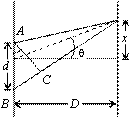Physics Assignment Help With Diffraction
14.13 Diffraction
Diffraction is a phenomenon characteristic of wave motion that occurs when a wave is distorted by an obstacle. The obstacle may be a screen with a small opening or a slit that allows only a small portion of the incident wave front to pass, or a small object, such as a wire or a disk, that blocks the passage of a small portion of the wave front. This effect becomes more and more noticeable as the dimensions of the slits or the size of the obstacles approach the wavelength of the waves.
14.13.1 Different types of diffraction: Fraunhofer and Fresnel
Diffraction of light is usually classified into two types: Fraunhofer and Fresnel diffractions. In Fraunhofer diffraction (or the far-field diffraction), the diffracting system (i.e an obstacle, or an aperture) is so away from the source that the waves generating the pattern may be regarded as plane. This can be achieved in the laboratory by making the rays of light parallel by placing the source at the focus of a convex lens. In Fresnel (or the near-field diffraction), on the other hand, the source of waves is so close to the diffracting system that the waves generating the pattern still retain their curved characteristics. The means that in Fresnel diffraction the convex lens is not used, and the wavefront remains spherical or cylindrical depends on the nature of the source. In the Fraunhofer class the wave front considered is plane, while it is spherical or cylindrical in the Fresnel class. In interference, we have two or more wave sources; while in diffraction, we have many, almost tending to infinity.
14.13.2 Fraunhofer diffraction by a single slit
According to Huygen's principle, every point in it acts as a source of secondary wavelets. The fact gives rise to interference between waves from various regions of the same slit.
Let us assume that as the plane wave-front reaches the slit, all points on it emit the secondary wavelets in the same phase. Thus if the disturbance is observed at point P on the far side of the slit at angle q to the normal, then there is a net path difference of BC = d sinq between the waves from the two edges of the slit AB.

(a)
![]()
The main difference between young's double slit pattern and Fraunhofer single slit pattern is that condition of maxima and minima are opposite.
Hence for minima or dark fringe
dsinq = nl
or ![]() from diagram
from diagram ![]() if q is very small then sinq = tanq
if q is very small then sinq = tanq
hence ![]()
![]()
where as for bright fringe
![]() Þ
Þ ![]()
From the figure ![]() If q is very small tanq = sinq hence
If q is very small tanq = sinq hence ![]()
Þ ![]() Also it is found that distribution of light on the screen is given by
Also it is found that distribution of light on the screen is given by

Email Based Assignment Help in Diffraction
We are the leading online Assignment Help provider. Find answers to all of your doubts regarding the Diffraction. Assignmenthelp.net provide homework, Assignment Help to the school, college or university level students. Our expert online tutors are available to help you in Diffraction. Our service is focused on: time delivery, superior quality, creativity and originality.
To submit physics Diffraction assignment click here
Following are some of the areas in physics Wave Optics which we provide help:


